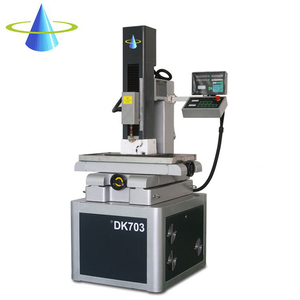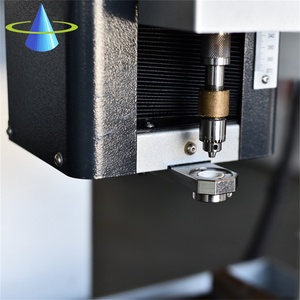
All categories
Featured selections
Trade Assurance
Buyer Central
Help Center
Get the app
Become a supplier

(1670 products available)


























The primary function of a drill bit-making machine is to automate the manufacturing process of drill bits, ensuring consistent quality, precision, and efficiency. Various machines can create different types of drill bits.
Grinding Machine:
A drill bit comprises multiple facets, typically formed by grinding. To create these facets, profile and form the grinding wheels are used, as is the drill bit to be ground.
Drilling Machine:
A single-drilling machine creates the holes in the drill bit. The entire workpiece is clamped to a table with an indexing head, which can be set up to drill a specific number of holes at a specific angle.
Shaping Machine:
Shaping involves the use of carving machines to fashion the drill bit out of a workpiece. This process is often computer-controlled, allowing for more complex and intricate shapes and designs. Generally, the unwanted material is removed to reveal the final drill bit.
Welding Machine:
Whether through laser, friction, or other methods, welding machines create the various parts of a drill bit. These include the shank, body, flutes, bit, and tip. Usually, the machine that does this is an electron beam machine. Because of the high forces and temperatures involved in welding, these bits must be very sturdy and strong.
Coating Machine:
Coating machines apply specialized coatings to drill bits that enhance their performance, durability, and resistance to wear. These coatings, such as titanium nitride, carbide, or other proprietary coatings, reduce friction, increase heat resistance, and prolong the life of the drill bit in challenging drilling conditions.
Capacity:
Machines are available with varying production capacities to manufacture a number of drill bits within a certain time period. Typical drilling bit production capacities are one to five bits per minute.
Automation:
Some machines are semi-automated while others are fully automated, meaning that they may require some manual supervision and intervention or none at all, respectively.
Power Source:
These machines usually have an electric or hydraulic power source. Drill Bit-Making machines with electric power sources use electrical energy to power their motors and control systems. Those with hydraulic power use hydraulic systems and pressure to control the movement and operations of the machine.
Material Compatibility:
The material the machine is compatible with refers to the drill bit blank material. The machine can manufacture drill bits from specific materials. These include carbon steel, HSS, carbide, and cobalt steel.
Dimension:
These machines differ in size and weight. Their dimensions depend on manufacturing processes, design, capacity, and technology.
Regular inspection.
Users must frequently examine the machines to determine if there are worn or damaged parts. The user needs to repair or replace any worn or damaged parts.
Lubrication:
Users should apply the recommended lubricant to the moving parts of the drill bit manufacturing machine on a regular basis. This reduces wear and tear and ensures smooth operation.
Cleaning:
The user should remove any drill bit-making machine debris or dirt on a regular basis, including leftover material and dust. Doing this ensures optimal functioning and prevents build-up of debris.
Calibration:
Users may have to calibrate the drill bit machine periodically depending on several factors such as usage intensity, manufacturing requirements, and precision demands. This ensures accuracy and maintains the bit's production quality.
Safety checks:
Users need to perform regular safety inspections. This ensures the safety devices of the drill bit-making machines are functioning as required. The user must also ensure that the guarding is in place, and the emergency stop mechanisms are working properly.
Industry players can use the drill bit manufacturing machines in various ways:
Consider these key factors of bit production devices when purchasing:
Product Variety
Buyers need to get machines that can make various drill bits, such as twist drill bits, spade bits, countersink drill bits, etc. These will allow buyers to satisfy different customers' needs and get a larger market share.
Bit Quality
To produce bits of high quality, buyers need machines with precise control systems. Such machines should also have good cutting speeds and feeds. Drill bits made by these machines will wear less and have a longer lifespan.
Material Compatibility
The bit production machine's compatibility with various materials is also an important consideration. Buyers need machines that can work with different materials like carbon steel, high-speed steel, titanium, etc. This will enable buyers to produce drill bits with varying material compositions to suit distinct applications.
Automation and Control
When shopping for drill bit production machines, buyers should consider the level of automation and control offered by the device. Buyers will need to choose between CNC machines, which offer a high level of automation and precise control, and more conventional machines with standard automation. This consideration will greatly influence the production efficiency and control.
Machine Size and Capacity
Buyers should consider the required drill bit making machine size and capacity depending on the expected production volume. Small-scale machines may be sufficient for low-volume production, while large-scale, industrial-sized machines are better for high-volume production.
Durability and Maintenance
It is a known fact that manufacturing machines are often exposed to harsh working environments. Thus, buyers need to get durable drill bit making machines. Such machines will offer low maintenance requirements and easy servicing.
With all the above considerations, buyers will get bit-making machines that are simple to set up and run, have low operating costs, and provide high production efficiency.
Q1 What are the latest developments in drill bit manufacturing technology?
A1. The latest developments in drill bit manufacturing technology have led to more effective drill bits. For example, Vortex, a new drill bit design, was developed after studying how water drains down a sink. In this instance, the goal was to make an airgap between the drill bit and the material being drilled to enhance the cooling of the drill bit. Laser technology is increasingly used to coat drill bits with diamond powder in a precise pattern. This patented process results in a more even, durable coating on the drill bits. Another new development in drill bit technology is the use of carbon-strengthened tungsten to manufacture drill bits. This new material is designed to withstand the extreme heat generated while drilling through tough materials, such as concrete with hardened steel. New drill bits have a modified shank geometry that provides a better fit in keyless drill chuck systems.
Q2 What are the key differences in the manufacturing process of industrial-scale and small-scale drill bits?
A2. Large-scale drill bit production uses automated CNC machines to produce more significant quantities of drill bits with consistent precision. In most cases, set-on drill bit gauges and drill bit setting blocks calibrate these machines, enhancing product consistency. However, small-scale production employs manual labor to produce unique drill bits. Specialized machines, like large-scale production drills, are usually not available for small-scale production. Consequently, artisans may use hand tools in combination with power tools to create small-scale pieces.
Q3 What are the advantages of investing in a drill bit-making machine?
A3. A drill bit-making machine will manufacture a variety of drill bits. This means that buyers will have more choices to offer their clients. When presented with an extensive selection of drill bits, businesses can quickly meet distinct consumer needs. This will enhance their market competitiveness. The machine will help an enterprise jump-start its product development. If it is a startup, for example, it will provide the company with an opportunity to begin immediate production. This will enable the company to improve its brand awareness and quickly establish its presence in the market. The drill-bit manufacturing machine will streamline the production process and improve efficiency by minimizing the steps required to manufacture a product. In the long run, the machine will reduce labor costs, as fewer workers will be required to operate it.
Q4 What are the major challenges in the manufacturing process of drill bits?
A4. Selecting the right material for the drill bit in pursuit of optimal performance and longevity is a challenge many manufacturers face. In addition to this challenge, some manufacturers must source high-performance, specialized coatings like titanium nitride on a drill bit (TIN) to enhance a drill bit's durability or to improve its precision.
A5. Some manufacturers struggle to meet strict international standards when it comes to drill bit production. The standards can vary depending on the market the manufacturer is trying to enter.
Q5 What are the main trends in drill bit manufacturing that private label buyers should follow?
A5. One drill bit manufacturing trend that private label buyers should follow is the growing demand for high-performance drill bits. Drill bits with unique features, such as self-feeding power, bits for difficult tasks like drilling through stainless steel, and bits with longer lives, are in high demand among professionals. Another trend is the shift toward eco-friendly drill bits. Bit buyers are now interested in drill bits manufactured from recycled materials or those with low environmental impacts. The need for customized drill bits to satisfy specific market requirements is also on the rise. Private label buyers are now shopping for drill bits that can be easily tailored in terms of size, shape, and coating to meet their customers' requirements.